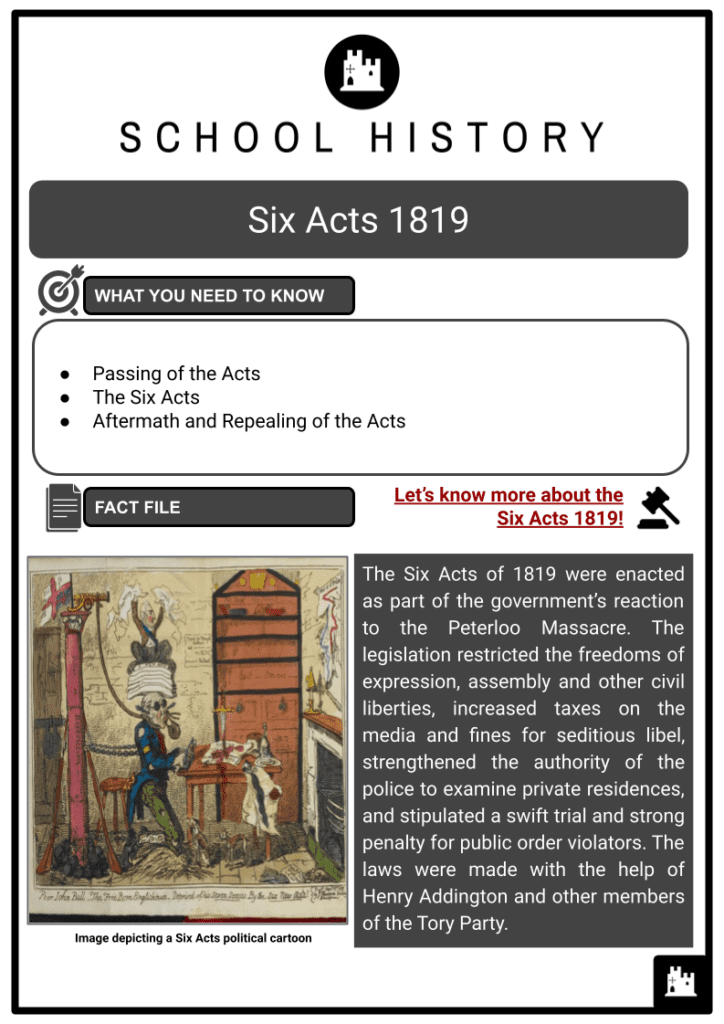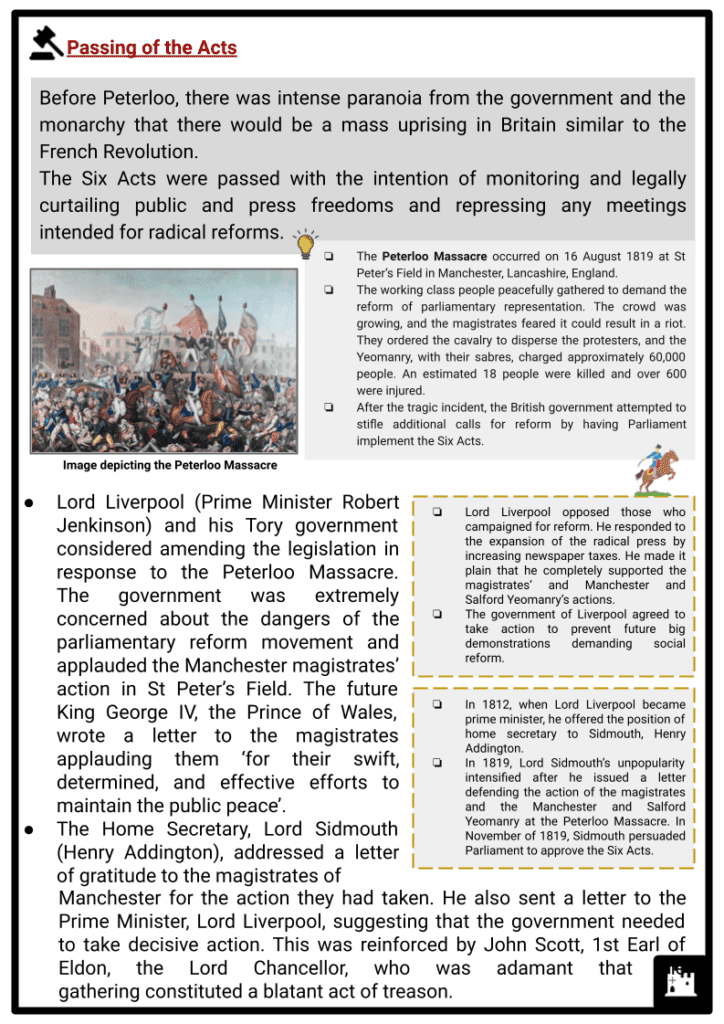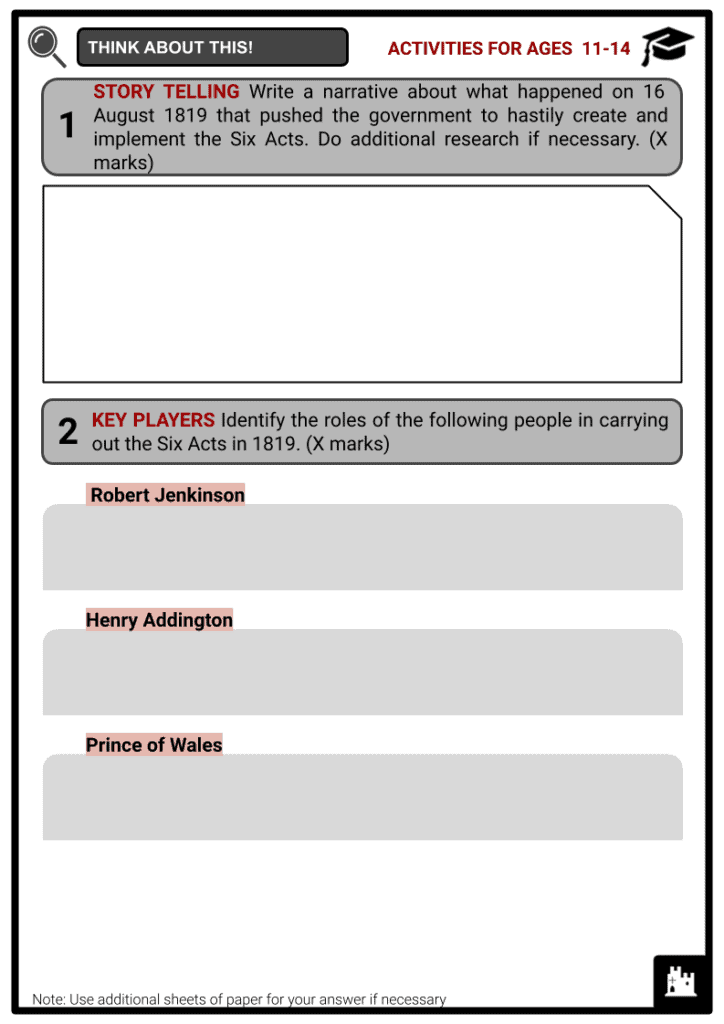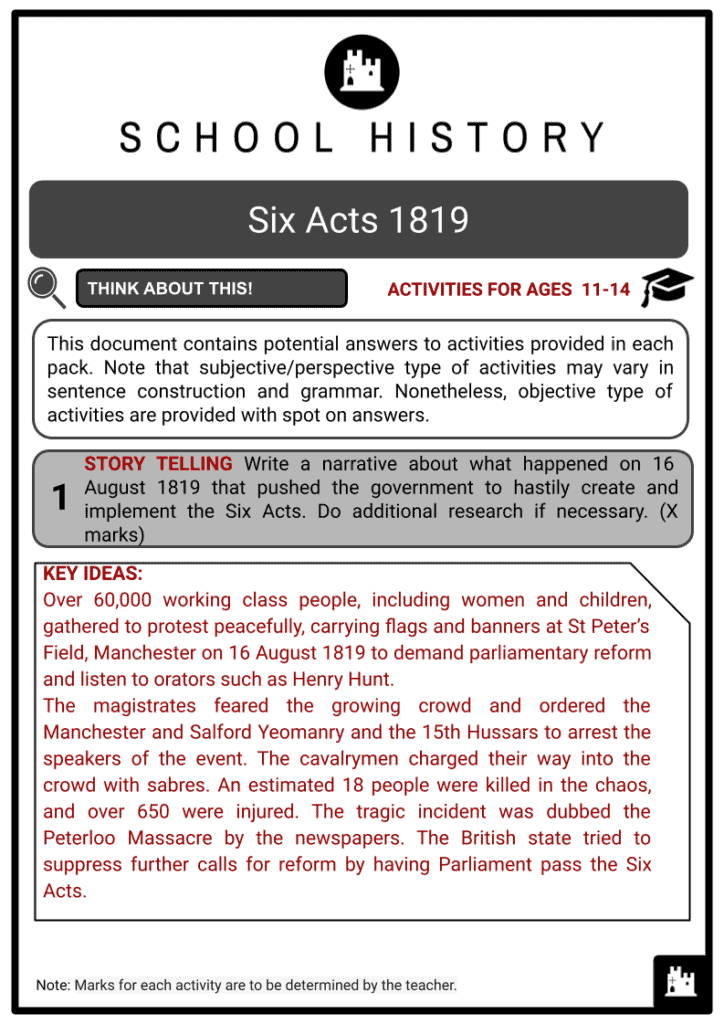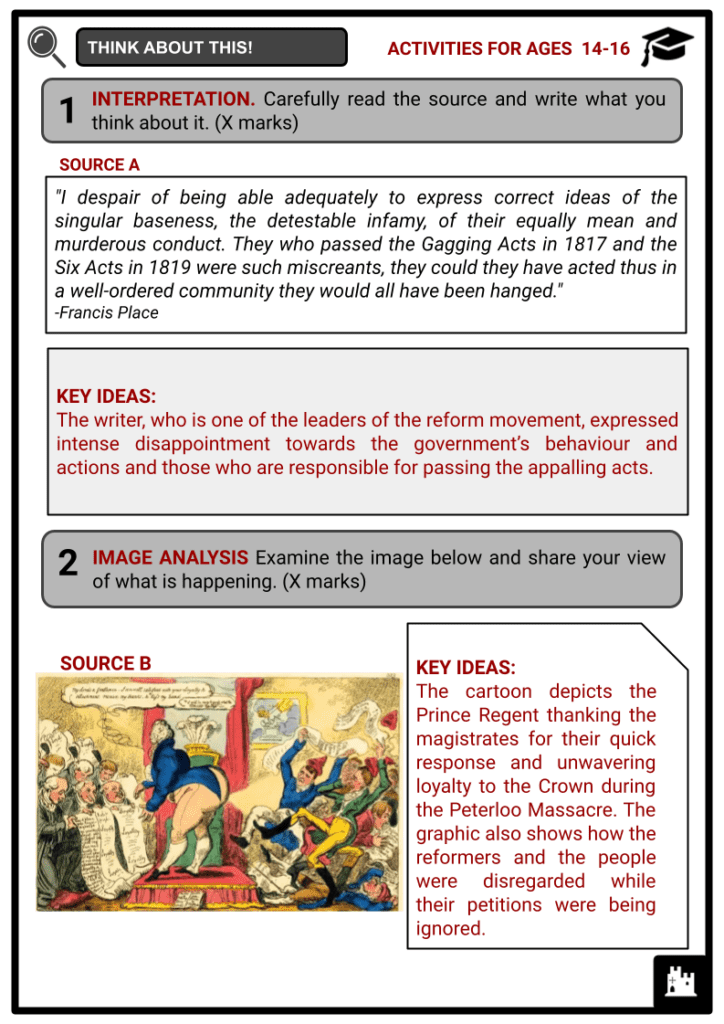Six Acts 1819 Worksheets
Do you want to save dozens of hours in time? Get your evenings and weekends back? Be able to teach about the Six Acts 1819 to your students?
Our worksheet bundle includes a fact file and printable worksheets and student activities. Perfect for both the classroom and homeschooling!
Summary
- Passing of the Acts
- The Six Acts
- Aftermath and Repealing of the Acts
Key Facts And Information
Let’s find out more about the Six Acts 1819!

The Six Acts of 1819 were enacted as part of the government’s reaction to the Peterloo Massacre. The legislation restricted the freedoms of expression, assembly and other civil liberties, increased taxes on the media and fines for seditious libel, strengthened the authority of the police to examine private residences, and stipulated a swift trial and strong penalty for public order violators. The laws were made with the help of Henry Addington and other members of the Tory Party.
Passing of the Acts
- Before Peterloo, there was intense paranoia from the government and the monarchy that there would be a mass uprising in Britain similar to the French Revolution. The Six Acts were passed with the intention of monitoring and legally curtailing public and press freedoms and repressing any meetings intended for radical reforms.
- The Peterloo Massacre occurred on 16 August 1819 at St Peter’s Field in Manchester, Lancashire, England.
- The working class people peacefully gathered to demand the reform of parliamentary representation. The crowd was growing, and the magistrates feared it could result in a riot. They ordered the cavalry to disperse the protesters, and the Yeomanry, with their sabres, charged approximately 60,000 people. An estimated 18 people were killed and over 600 were injured.
- After the tragic incident, the British government attempted to stifle additional calls for reform by having Parliament implement the Six Acts.
- Lord Liverpool (Prime Minister Robert Jenkinson) and his Tory government considered amending the legislation in response to the Peterloo Massacre. The government was extremely concerned about the dangers of the parliamentary reform movement and applauded the Manchester magistrates’ action in St Peter’s Field. The future King George IV, the Prince of Wales, wrote a letter to the magistrates applauding them ‘for their swift, determined, and effective efforts to maintain the public peace’.
- The Home Secretary, Lord Sidmouth (Henry Addington), addressed a letter of gratitude to the magistrates of Manchester for the action they had taken. He also sent a letter to the Prime Minister, Lord Liverpool, suggesting that the government needed to take decisive action. This was reinforced by John Scott, 1st Earl of Eldon, the Lord Chancellor, who was adamant that the gathering constituted a blatant act of treason.
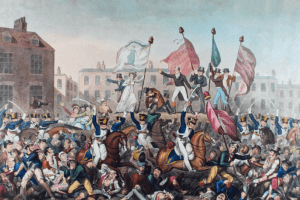
Image depicting the Peterloo Massacre - Lord Liverpool opposed those who campaigned for reform. He responded to the expansion of the radical press by increasing newspaper taxes. He made it plain that he completely supported the magistrates’ and Manchester and Salford Yeomanry’s actions. The government of Liverpool agreed to take action to prevent future big demonstrations demanding social reform.
- In 1812, when Lord Liverpool became prime minister, he offered the position of home secretary to Sidmouth, Henry Addington. In 1819, Lord Sidmouth’s unpopularity intensified after he issued a letter defending the action of the magistrates and the Manchester and Salford Yeomanry at the Peterloo Massacre. In November of 1819, Sidmouth persuaded Parliament to approve the Six Acts.
The Six Acts
- On 23 November 1819, when Parliament reconvened, Sidmouth presented the specifics of what became known as the Six Acts. The primary objective of the act was to limit radical publications and gatherings as well as the threat of armed revolt.
Training Prevention Act
- It became unlawful to attend a gathering for the aim of acquiring weapon training. The punishments for attending such a gathering included two years in prison or seven years of transportation.
- Any type of military training had to be done by only municipalities and above.
- It is now referred to as the Unlawful Drilling Act of 1819.
Seizure of Arms Act
- It broadened the power that was granted to the local magistrates. It gave them the authority to enter private property to seize weapons and arrest the owners of those weapons.
- It criminalised the instruction of private persons in the use of guns.
Misdemeanours Act
- It expedited the process of prosecuting a person accused of a crime by restricting bail opportunities.
- At the King’s Bench in Westminster or Dublin, opportunities to prolong pleading or demurring were limited to four days.
Seditious Meetings Act
- The law required the approval of a sheriff or magistrate to conduct a public meeting of more than 50 individuals if the assembly’s subject matter involved ‘church or state’ matters.
- Those who were not local residents were not permitted to attend such sessions.
Newspaper and Stamp Duties Act
- It increased and expanded taxes to cover newspapers that had avoided paying taxes by publishing opinions instead of news. Publishers had to put up a bond as well as promise to behave.
- These taxes drastically limited the amount of those who could afford to purchase newspapers.
Blasphemous and Seditious Libels Act
- It strengthened the existing regulations to offer harsher punishments for anyone who produced publications judged to be blasphemous or seditious. The maximum punishment was raised to fourteen years in prison and banishment.
- In response to the Six Acts, a number of reform newspapers, including The Cap of Liberty, Manchester Guardian, and Medusa, collapsed, while others explored innovative ways to avoid the legislation.
- One such instance was William Hone’s pamphlet, Man in the Moon, which satirised the Prince Regent’s speech on the early re-opening of parliament, and demonstrated that, while prose could be prosecuted for sedition, parody and verse could be much more effective and were much more difficult to prosecute.
Aftermath and Repealing of the Acts
- The Six Acts were opposed by the Whigs on the grounds that they violated the rights and liberties of the people. They cautioned that it was illogical to pass national laws to address problems that existed exclusively in certain regions. These measures, according to the Whigs, would inspire radicals to become even more rebellious.
- Between 16 and 27 March 1820, the trial of the leaders of the St Peter’s Field gathering took place in York. The men were charged with ‘assembling with illegal banners during an illegal gathering with the intent to stir up dissatisfaction’. Henry Orator Hunt was found guilty and sentenced to two years and six months in Ilchester Gaol. Joseph Johnson, Samuel Bamford and Joseph Healey were each given a one-year prison sentence.
- The Black Dwarf was among the most widely known newspapers, with a circulation of approximately 12,000. The editor of the unstamped newspaper was Thomas Jonathan.
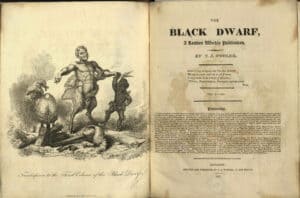
Image depicting The Black Dwarf Newspaper - Wooler was arrested and accused of ‘creating a seditious conspiracy to elect a representative to Parliament without lawful power’ after the passage of the Six Acts. Wooler was found guilty and given a sentence of 18 months in jail.
- Nationwide petitions were received in opposition to the loss of rights. Many of these petitions were presented to the House of Commons, but the majority of its early records were ruined in a fire in 1834. Two petitions against the Six Acts were presented to the House of Lords: one from Rochester and one from Southwark.
- On 15 December 1819, the petition signed by the citizens and residents of Rochester was brought to the Lords. The Six Acts were regarded as ‘subversive of the British Constitution’, and ministers were accused of destruction of the people’s rights. The petition from Southwark, given to the Lords on 21 December 1819, less than a week later, complained about the Seditious Meetings Bill in particular. These petitioners saw the proposed legislation as an attempt to abolish rights and liberties by preventing the people from gathering to discuss their problems and to petition.
- These statutes were enacted in an attempt to exert control over the populace, but they were ineffective and generated considerable opposition. According to some historians, these steps appear rather minor and rarely were the new sentences imposed.
- The banishment penalty was removed from the Blasphemous and Seditious Libels Act in 1830.
- The restriction on drilling was enforced throughout the 20th century and was finally lifted in 2008. The Seditious Meetings Prevention Act had a five-year time limit and was abolished in 1824.
- According to historian George Macaulay Trevelyan, the four-penny stamp duty imposed by the Newspaper and Stamp Duties Act caused the longest lasting harm to the community, but even this was reduced to one penny in 1836, and all taxes on newspapers, also known as ‘taxes on knowledge’, were completely repealed between 1853 and 1861.

